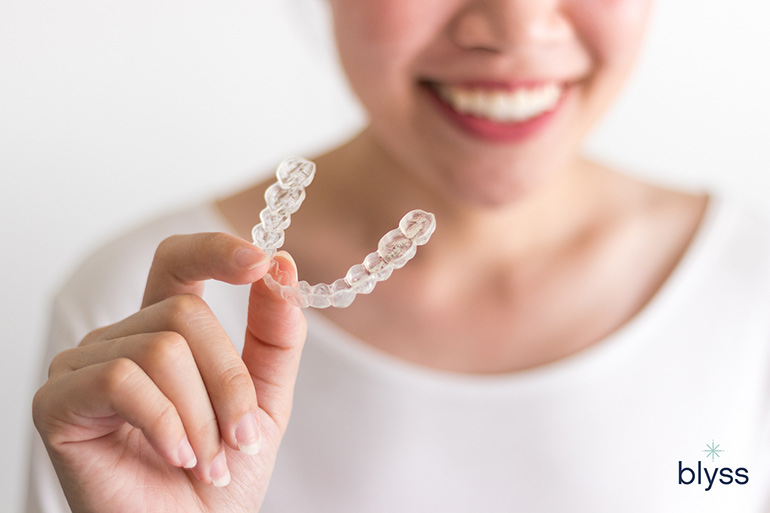If you’re like most coffee lovers, you probably don’t think twice about the coffee stained teeth. After all, a little bit of coffee never hurts anyone, right?
Actually, it might be doing more harm than you think.
Whether you’re an avid coffee drinker or only indulge in a cup every now and then, it’s likely that your teeth may be a victim of persistent stains.
While coffee can cause stains on teeth, there are actually a variety of other causes. From medications to genetics to lifestyle choices, this post will explore all the possible causes of stained teeth and uncover the best ways to prevent or treat them.
Types of Teeth Stains
There are two main types of teeth stains: extrinsic and intrinsic.
Extrinsic stains occur on the outer surface of your teeth and are commonly caused by things like coffee, tea, red wine, tobacco products, or foods with strong pigments like blueberries or beets. I know. I love the health benefits of cooking with turmeric for my family. But as a dentist, I am always concerned about teeth staining.
These types of stains can generally be addressed with at-home or professional teeth-whitening treatments.
Drinks such as Coke and tea contain tannins, which can cause even more discoloration than your daily brew. It’s also worth mentioning that some lifestyle choices, such as smoking, can also contribute to stained teeth in addition to your cup of joe.
Intrinsic stains occur below the surface of your teeth and can be trickier to treat. These types of stains are generally related to certain medications or illnesses, age-related wear and tear, or dental trauma. For example, taking tetracycline antibiotics while you are pregnant can cause your baby’s teeth to have colored bands. I offer treatments that include veneers and crowns, which can help mask the stained teeth permanently.
What Causes Stains on Your Teeth?
Many people who rarely or never drink coffee still suffer from discolored, stained teeth because of many other factors.
Poor oral hygiene, the natural aging process, smoking, and certain medications can all contribute to teeth staining. Here’s why:
Poor Oral Hygiene Habits
Poor brushing and flossing allow plaque and bacteria to build up on the surface of our teeth. This biofilm can harbor stains from food, drinks, and tobacco products, leading to discoloration that won’t come off with just a toothbrush and floss.

Ignoring your oral hygiene can cause plaque and tartar buildup that stains the teeth and leads to calculus deposits.
Aging
As we get older, the enamel on our teeth begins to wear away, exposing the yellow dentin underneath. Additionally, our saliva becomes less effective at washing away debris, leading to further buildup and discoloration.
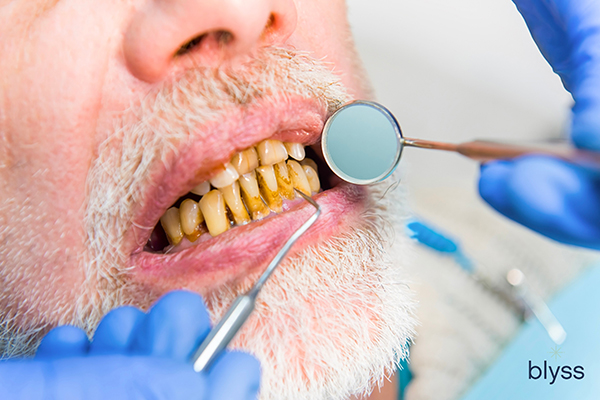
Plaque deposits and acid erosion from food (such as citrus fruits) and drinks (such as alcohol) can take their toll on aging teeth, leaving them discolored and stained.
Diet
Eating too much sugar can increase the risk of tooth decay by providing fuel for oral bacteria. Similarly, acidic foods like citrus fruits and vinegar can erode tooth enamel, making it more susceptible to staining.
Smoking
Over time, nicotine and tar can build up on your enamel and turn your pearly whites a yellow or brown color. It’s not just the nicotine in cigarettes that can cause staining, but also the heat and smoke from each puff.

The smoker’s smile can reveal far more than just a yellow discoloration. Cigarette smoke contains chemicals that can permanently stain and damage teeth over time, leading to enamel erosion and cavities.
Medications
Certain medications, such as antibiotics, antidepressants, and antipsychotics, contain tannins and other ingredients that can lead to discoloration of the teeth. The acidity of these compounds can weaken the enamel and allow staining agents like coffee to penetrate deeper into the tooth.
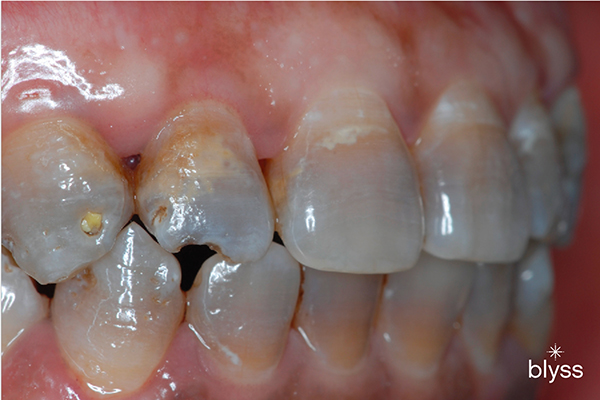
Long-term use of some medications can negatively affect the appearance of your teeth, leaving them stained and trickier to treat than other causes.
Trauma to the Teeth
When trauma occurs, chips and cracks in the protective enamel layer can lead to all sorts of problems with how your teeth look and feel. Cracks on the surface of the tooth leave tiny crevices where food particles can get lodged and stain the area.
Genetics
The truth is that some people, due to their genetic makeup, have tooth enamel that is more porous than others. This makes it easier for stains from foods, beverages, and even smoking to become embedded in the enamel and cause discoloration.
Health Conditions
Some medical conditions, such as certain autoimmune diseases like lupus and Sjogren’s syndrome, can cause dry mouth (xerostomia). This reduces saliva production and makes it harder for our bodies to protect against the bacteria that cause staining in our mouths. Acid reflux is another condition that can cause dental staining. The acidic content of stomach acid tends to erode the enamel of teeth, exposing the underlying yellow dentin.
Treatment Options for Your Stained Teeth
If you’re dealing with stained or yellow teeth, there are several treatments you can pursue to help restore the natural whiteness of your smile.
At Blyss Dental, I offer a range of professional treatments that can help restore your smile and erase years of discoloration.
If you’re someone who prefers taking matters into their own hands, there are many over-the-counter products to help whiten teeth. However, these solutions may not offer the same results as professional treatments.
Over-the Counter Products
- Whitening Toothpaste – Most whitening toothpastes contain mild abrasives which scrub away surface stains, as well as bleaching agents like peroxide or carbamide which penetrate deeper into the enamel.
Blyss Dental Tip: These kinds of toothpaste tend to be very abrasive. It takes away some of your healthy enamel and leads to tooth sensitivity.
- Whitening Strips – These thin, flexible strips are coated with a peroxide-based whitening gel and are applied directly to the teeth. They’re a popular option because they’re relatively inexpensive and can be used in the comfort of your own home.
- Whitening Pens – These handy little devices contain a gel that can be applied directly to the teeth, allowing you to target specific areas that need a little extra TLC. They’re great for touch-ups between whitening treatments or for on-the-go use.
- DIY Whitening Kits – These kits typically include a set of trays that you mold to fit your teeth, as well as a whitening gel that you apply to the trays. They can be effective, but be sure to follow the instructions carefully to avoid damaging your teeth or gums.
Blyss Dental Tip: As a dentist, I strongly advise against DIY dentistry. Attempting to perform dental procedures without the proper knowledge, skills, and equipment can result in serious harm to your teeth and gums, and be dangerous to your overall health. Instead, schedule regular check-ups with your dentist and address any dental concerns with a professional for the best possible care.

The contents and effectiveness of a DIY teeth whitening kit can vary depending on the brand and type of kit. But typically, it includes a whitening agent, a tray or applicator, a desensitizing agent (optional), a shade guide, instructions, and other accessories (such as an LED light or storage case).
Professional Dental Treatments
- Professional Teeth Whitening – This treatment involves bleaching agents that penetrate deep into the enamel and dentin of your teeth to lift out discoloration and lighten the shade of your teeth. Professional whitening typically yields longer-lasting results than over-the-counter whitening products.
- Dental Bonding – This is a process where a tooth-colored resin is applied to the surface of the teeth. The material is then hardened with a curing light and polished for a natural-looking finish. This treatment is perfect for minor cosmetic issues like chips or gaps in between your teeth, as well as reducing the appearance of stubborn yellowing on your front teeth.
- Dental Crowns – Dental crowns are custom-made caps that fit over damaged or weakened teeth like a glove. This protects them from further damage while giving you natural-looking teeth.
- Dental Veneers – Veneers are thin shells that are custom-made to fit over the front of the teeth. They’re typically made from porcelain or composite resin and can help improve the appearance of teeth that are stained, chipped, or misaligned.
The effectiveness of these types of treatment may vary depending on the severity and type of stain.
Ceramic Veneers: The Ultimate Solution for Stained Teeth
Yes, you read it right. I recommend ceramic veneers as the ultimate solution for stained teeth.
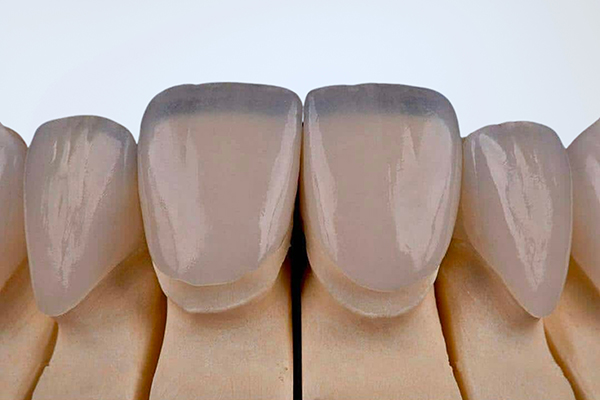
Ceramic veneers can treat stained teeth by covering the existing tooth surface with a thin porcelain shell, which provides a permanent solution that is resistant to future staining and can correct various types of discoloration.
Ceramic veneers are custom-crafted porcelain shells that fit perfectly over the front of your teeth and mask coffee stains and other discoloration. They are extremely durable and stain-resistant, making them ideal for those who regularly consume dark drinks like coffee.
Plus, it’s easy to get the perfect color with ceramic veneers. I can match the color of your veneers to your natural tooth color, blending them perfectly.
And since ceramic is so durable, you don’t have to worry about damaging them. With proper care, ceramic veneers can last for 10–15 years, making them a long-term investment in your smile.
But perhaps the best thing about ceramic veneers is the confidence boost they can provide. No longer will you feel self-conscious about stained, misshapen, or otherwise flawed teeth. Instead, you’ll have a beautiful, radiant smile that you can’t help but show off.
So if you’re tired of dealing with coffee-stained teeth, book a free consultation with me to find out if you’re a good candidate for ceramic veneers.
Begin Your Journey to Whiter Teeth at Blyss Dental
If you’re dealing with stained teeth, you don’t have to live with it!
As it turns out, there are a number of reasons why stained teeth can occur that have nothing to do with your daily cup of joe. It could be genetics, medications you take, or even medical conditions like acid reflux.
The good news is that there are many treatments available to brighten and whiten your smile, such as ceramic veneers, regardless of the cause of the staining. To find out more, visit Blyss Dental for a free consultation.
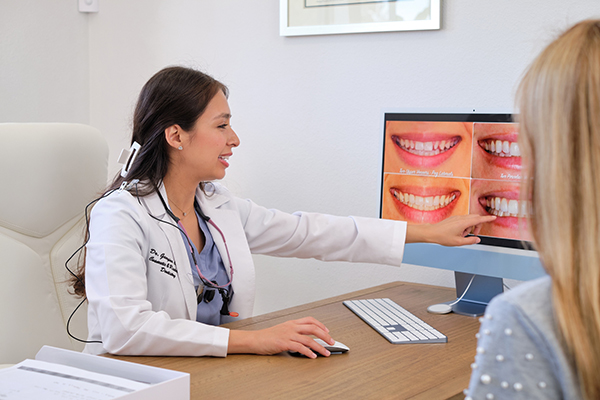
At Blyss Dental, we understand how frustrating it can be to deal with stained teeth. That’s why we offer free consultations and tailored treatment plans to help you get rid of those pesky stains and restore your smile.
Call us today for your free consultation and experience the difference!
Sources Cited From
- Sulieman M. An overview of tooth discoloration: extrinsic, intrinsic and internalized stains. Dent Update. 2005 Oct;32(8):463-4, 466-8, 471. doi: 10.12968/denu.2005.32.8.463. PMID: 16262034.
- Chung KT, Wong TY, Wei CI, Huang YW, Lin Y. Tannins and human health: a review. Crit Rev Food Sci Nutr. 1998 Aug;38(6):421-64. doi: 10.1080/10408699891274273. PMID: 9759559.
- Alkhatib MN, Holt RD, Bedi R. Smoking and tooth discolouration: findings from a national cross-sectional study. BMC Public Health. 2005 Mar 24;5:27. doi: 10.1186/1471-2458-5-27. PMID: 15790389; PMCID: PMC1079878.
- Haralur SB. Effect of Age on Tooth Shade, Skin Color and Skin-Tooth Color Interrelationship in Saudi Arabian Subpopulation. J Int Oral Health. 2015 Aug;7(8):33-6. PMID: 26464536; PMCID: PMC4588786.
- Thomas MS, Denny C. Medication-related tooth discoloration: a review. Dent Update. 2014 Jun;41(5):440-2, 445-7. doi: 10.12968/denu.2014.41.5.440. PMID: 25073226.
- Edelhoff D, Prandtner O, Saeidi Pour R, Liebermann A, Stimmelmayr M, Güth JF. Anterior restorations: The performance of ceramic veneers. Quintessence Int. 2018;49(2):89-101. doi: 10.3290/j.qi.a39509. PMID: 29292405.


